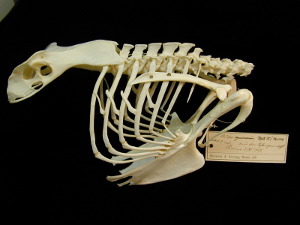Evolutionary Respiratory Morphology
We are interested in understanding how constraints have shaped the respiratory and locomotor systems of birds and their dinosaurian ancestors.

This is carried out through comparative physiology, anatomy, functional morphology and biomechanical analysis of appropriate taxa.
Current Research:
Mechanics of Ventilation: the avian respiratory system is remarkable in terms of its complexity and efficiency. The evolution of this system with its unique lung morphology and physiology has contributed to birds becoming one of the most successful vertebrate lineages.
Like all tetrapods the ancestors of birds can be found among the fishes, meaning these animals have evolved accessory breathing mechanisms to circumvent Carrier’s Constraint – maintaining breathing during locomotion. Key to understanding this has been examination of the uncinate processes in birds and other dinosaurs. The uncinate processes are bony ossified projections that extend posteriorly from the proximal edge of the vertebral ribs in most species of extant birds. These processes are integral to the mechanics of ventilation in extant birds and have been hypothesised to playing a key role in both inspiration and expiration in the Maniraptoran dinosaurs.
We have recently conducted research to investigate how morphological variations in these processes demonstrate that constraints placed on the body by adaptations to different forms of locomotion. Our research indicates that adaptations are key to understanding differences in how birds breathe and locomote.
A key interest of the group is to place our research in an evolutionary framework by using information from extant species to reconstruct the evolution of respiration in extinct archosaurs. We have done this for Velociraptors and are currently seeking to further this work in other Archosaurs.



